Sampling a very rare 1979 Peugeot 304 delivery van
Posted by Chris Graham on 13th June 2024
Brian Culpan tells the interesting story of a 1979 Peugeot 304 delivery van with classic sports car connections.
Photography: Brian Culpan and Andrew Hardy
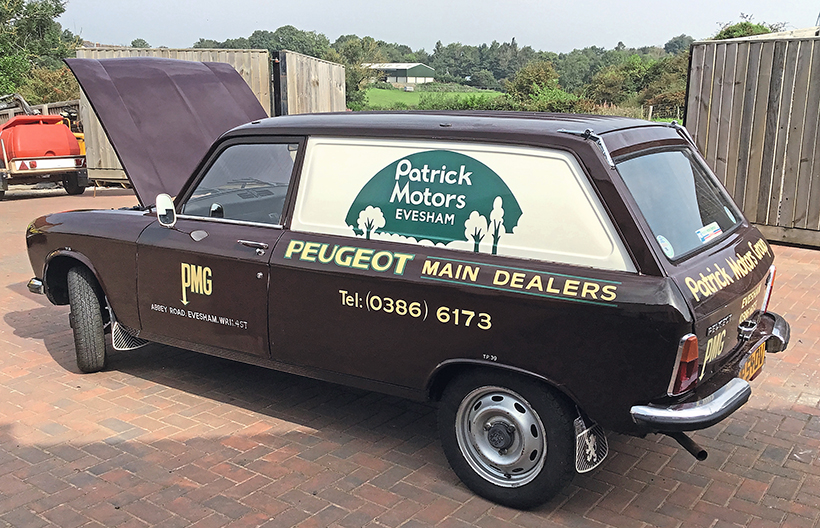
The Peugeot 304 van shares the estate’s bodyshell.
This van carries a name that was very significant in the history of motor industry. It has always belonged to Patrick Motors Ltd. (at one time known as Patrick Jensen Motors Ltd) a long-standing Midlands motor distributor based in Selly Oak, Birmingham (the site is now a Tesco Extra store).
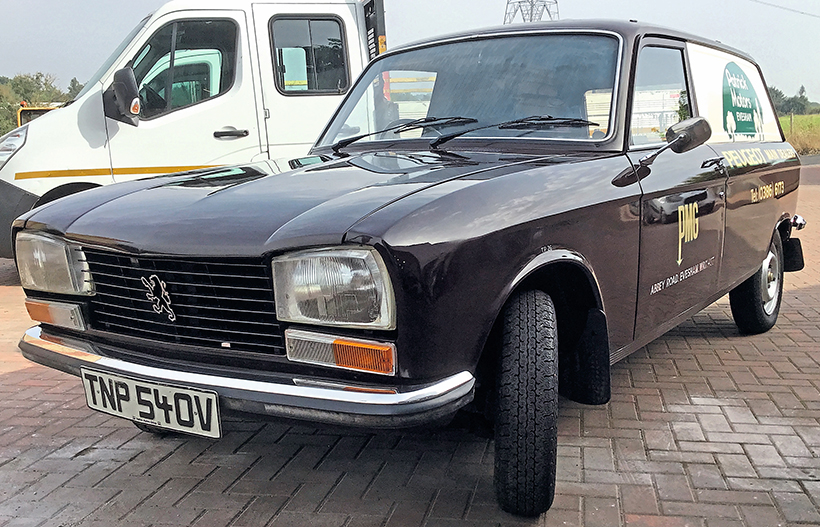
A rare sight now, the Peugeot 304 van.
In 1930, Albert Patrick, a wealthy director of Britannic Assurance Co. (specialists in life insurance) bought Edgbaston Garage on the Bristol Road in Selly Oak, to provide a secure employment future for his son, Joseph. Young Joe was mad about cars – fast sports cars in particular and thrust himself totally into the business. He had the good fortune to meet and soon employ a couple of equally enthusiastic brothers, Alan and Richard Jensen. They had been tinkering with small, old cars, removing the body and replacing it with a sports car special of their own design – but this would be their big break; a chance to make a big impression on the motoring world.

A rare survivor.
They re-organised the garage; a coachbuilding department was created and a genius of an idea was to start offering night servicing and Sunday opening – unheard of at the time. They also created small sports cars built on the Wolseley Hornet and Austin 10 chassis. The business was very successful; so much so, that the Jensen brothers were made directors. Unfortunately, it didn’t last, within a year the brothers had departed to form their own business – Jensen Motors Ltd, that would blossom into an extremely large long-lived organisation.
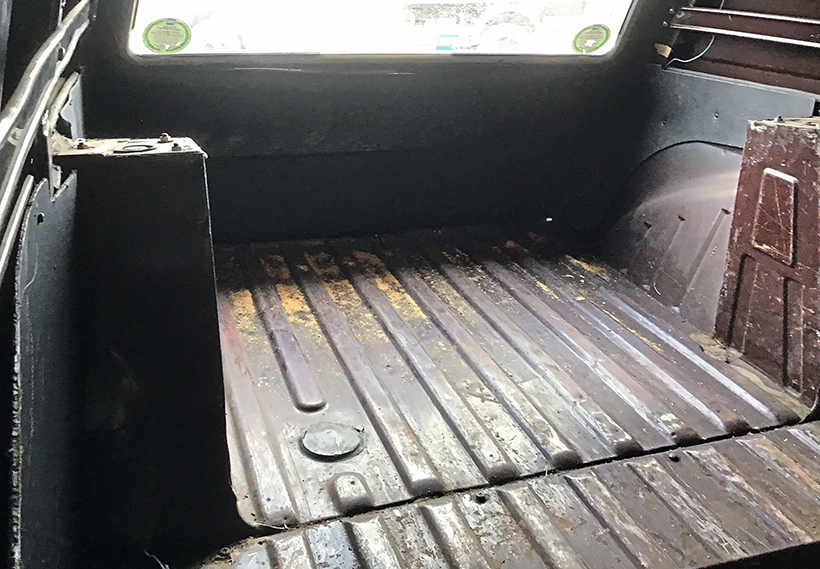
A well-used load area.
The other half of the partnership reverted to its original name of Patrick Motors and was also successful building over 1,000 ‘Special’ sports cars; before settling down to be a large Austin distributor. In 1959, it became a Daimler dealership (and BMC), then Peugeot (still retaining the connection with Austin franchise – now known as British Leyland). From 1960, a collection of cars had been built up and became a small museum – this Peugeot 304 van was kept as one of the exhibits – along with other service vans from the garage.
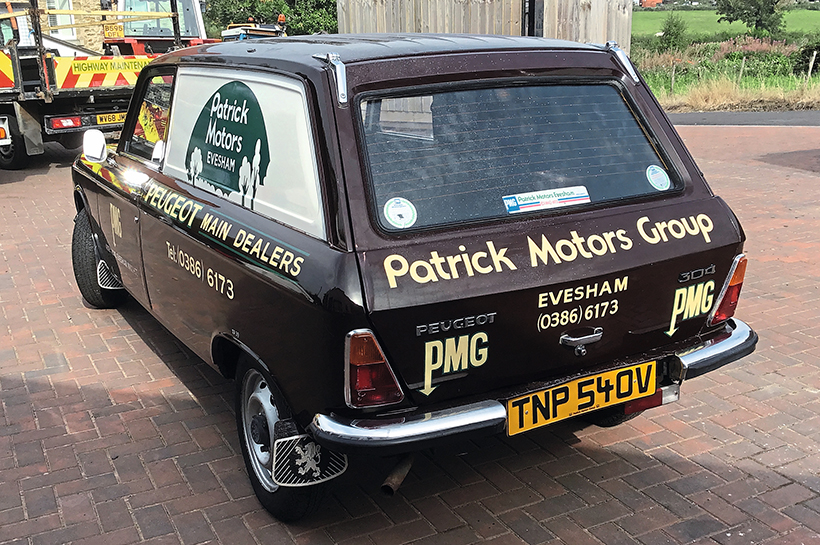
Big, wide tailgate makes loading easy.
As a parts delivery vehicle, the Peugeot had ‘clocked up’ over 30k miles and became surplus before an MoT would have been due on its third birthday; the nature of the dealership had moved on, its replacement parts van was from the British Leyland family – a Morris Ital, soon followed by an Austin Maestro.

Diff and engine sump, the exhaust takes a diversion around them.
Starting around 1994, the business changed its focus; to concentrate on business property management. Eventually, in 2023 the collection of old vehicles, amassed over many years, was disposed of in two auctions, the van was in the second one organised by Bonhams; held in early September 2023; at the National Motor Museum in Beaulieu. It was designated lot 503 with an estimate between £1k-£3k. The bidding went way beyond that – maybe potential buyers knew more of the significance history than the auctioneers’ advisors. It was there that Andrew Hardy bought the van and brought it north to Durham.

Extremely tidy engine bay for a working van.
First registered with Worcestershire County Council of 5 November 1979 as TNP 540V, production ended in 1980. The van was used for parts delivery at the Evesham branch. Since being retired in 1982 when it would have been due an MoT test as a three-year-old, it has not been used but put away in the PMG’s private museum. So, considerable recommissioning is being carried out carefully, in-house, by Mark Shipley. The engine has not been fired up yet. The bodywork is good both on top and underneath (including brake pipes). This is not surprising since it was only in use for such a short time; encountering the ravages of salt and grit on winter roads, only two or three times.
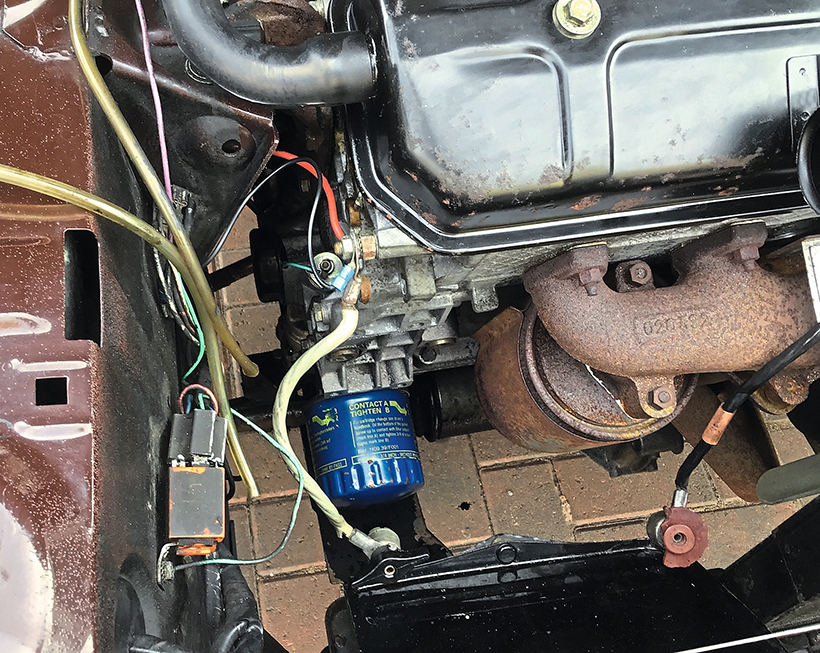
Easy access, spin-on oil filter.
The body does show signs of a busy (not abused) life, with small dings and dents, tiny scratches inflicted by other drivers when not parking up carefully, but these are part of the van’s history and would be appreciated by enthusiasts if kept. Sign-writing is the real thing, done professionally by hand using paint – looking closely, the confirming brush marks can be seen. Thoughtfully the required tyre pressures are marked above each wheel arch to remind users. Around the roof perimeter are small, built-in, mountings for a large roof rack.

Bonnet is secured at both front corners.
To save on unnecessary expense, the van came in a standard factory shade, a dark chocolate and this was kept. The livery wording is: PMG (Patrick Motors Group), Evesham Branch, Worcs. Since this is the original livery, it gives the phone code in the old format; 0386 for Evesham; predating the introduction of 01 prefixes on 6 April 1995. Curiously the number 0386 is now regarded as a suitable fictitious one for use in TV and film productions.
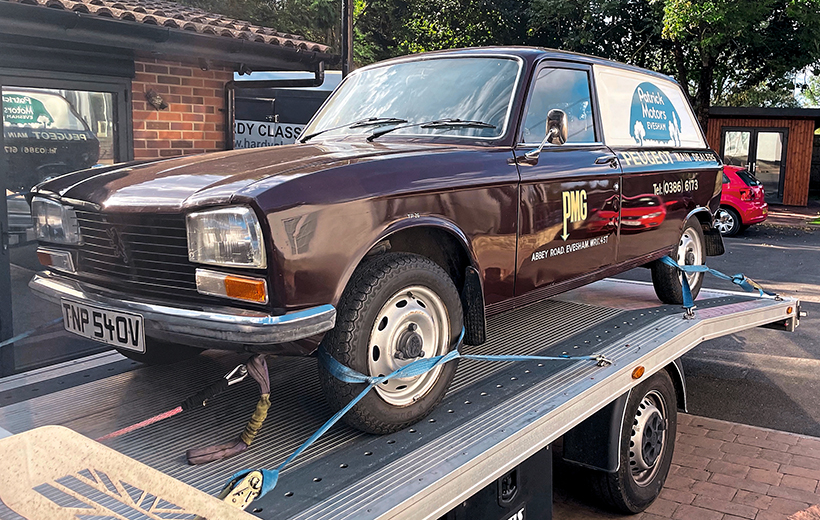
Carefully strapped down for the long journey north.
Model history
Peugeot’s model numbering system (of a few years ago) always contained a central 0 digit, the prefix indicated the vehicle size, the suffix the version of that model. Introduction of the 304 was intended to fill the gap between the 204 and the 404, interpreting the 204 and 304 model designations strictly, it would suggest two identical versions of the same model differing only in engine size and internal trim – and that’s exactly what these were.
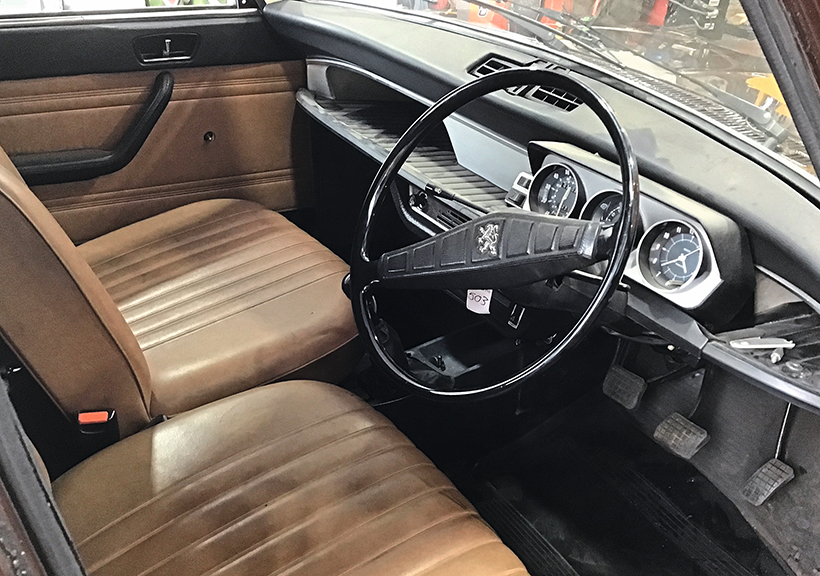
Cab is extremely roomy thanks to a transverse, front-wheel drive package.
These two vans were very similar – in fact they shared the same basic body shell but with minor front and rear styling differences, – just a more powerful 204 by being given a larger power unit, and with a slightly restyled front featuring the trapezoidal headlamp units made famous by the larger 504. So, it was surprising that they were sold alongside each other for a while. The van version was not introduced until September 1977. Eventually the two were superseded by new models – the legendry 205 and the larger 305.

Eye-catching livery has hand-painted sign-writing.
The 204’s design had been a big leap forward for Peugeot – being its first front-wheel drive design, first with front disc brakes, and all- round independent suspension. Also, its engine was the first transversely position unit from the French company. Peugeot engineers had closely studied the BMC Mini of 1959 and in fact, started their own extremely similar design later that very same year!
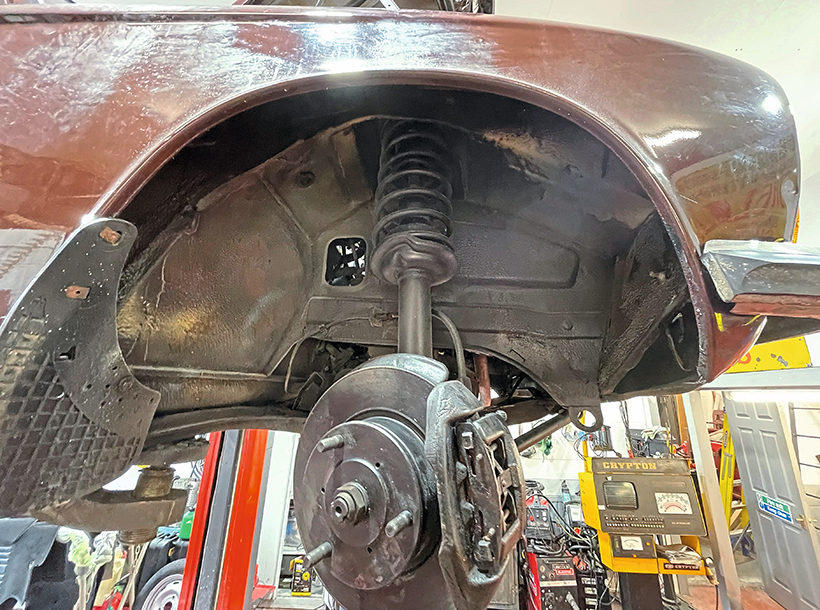
Front suspension struts in a very clean wheel arch.
The 204 Model began its development as Project D in 1959; ending as D12 as changes were made. The saloon was introduced first in Paris on 23 April 1965 (copies of drawings had been leaked as early as 1963! and photographs of prototypes in December 1964). So, what emerged at launch was not a surprise!

Rear suspension vertical struts with coil spring on a trailing arm.
The van version came much later in October 1966. It was aimed at a new segment of the market so consequently had no direct predecessor (the nearest was the old 403 van although it was larger with rear wheel drive). The new van could carry the same loads (450kg and 1.5 cu.m) but in a more efficient package. The 304 continued with this package, bodywork styling was by Pinin Farina.

Stylish two-spoke steering wheel.
The bonnet is secured by two locks; one at each front corner. Inside the engine bay is extremely clean and tidy. The VIN plate gives the details: Type 304T01 = Model 304, petrol engine, first generation. The engine and driveline followed BMC’s Mini arrangement; transverse engine, front-wheel drive, gearbox and diff underneath and both share the engine’s oil. Rack and pinion steering, all squeezed into a small, compact package allowing a lot of cab space.
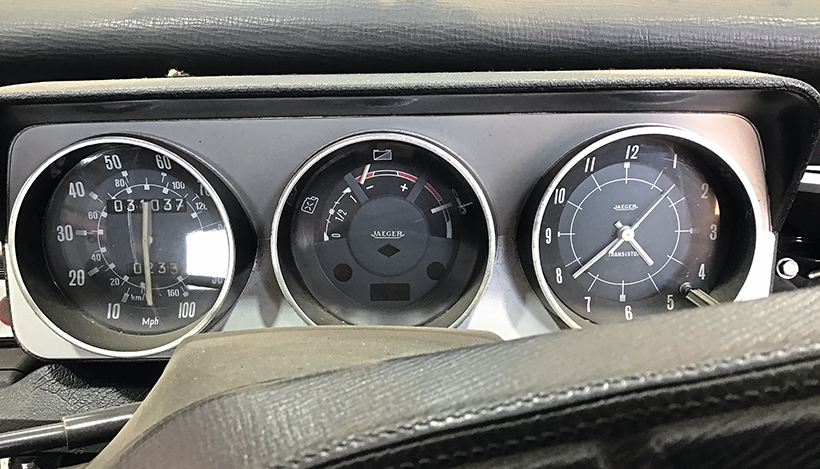
Very comprehensive dash panel gauges.
However, Peugeot improved on Issigonis’ design by having an all-alloy engine with wet liners (coolant surrounds these), and a single overhead camshaft, known as Type 118 XL5 = a 4 cylinder, 1290cc, 5th generation 65bhp petrol unit. A major benefit was the all-synchromesh gearbox; many competitors didn’t fit synchromesh to first gear. Independent suspension was fitted all round; MacPherson struts at the front with rear trailing arms, with vertical struts and coil springs. The front disc rear drum brakes were by Girling.
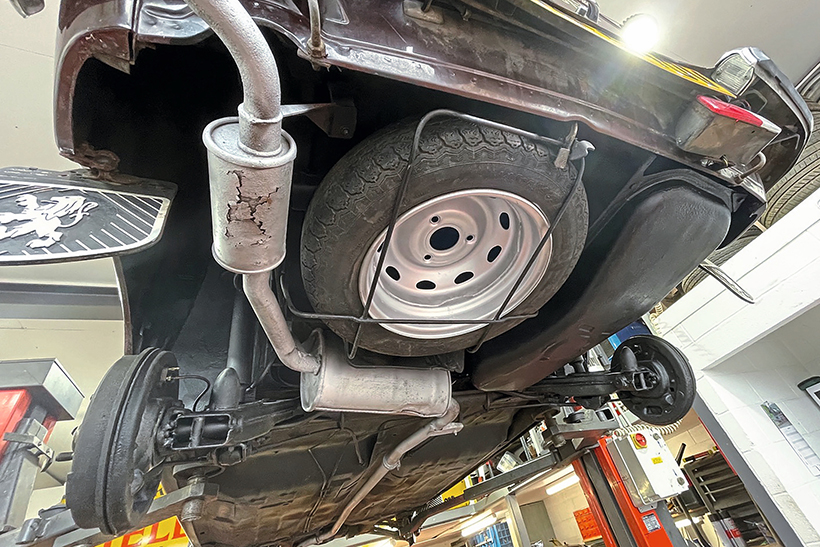
Two silencers, spare wheel, and oddly shaped petrol tank.
Unusual belt drive
A problem can arise when adopting a transverse engine; where to put the radiator? The Mini design simply installed it on the end of the power unit on the nearside; where it could still have its fan driven by v belt from the crankshaft pulley. Peugeot engineers wanted it go in the traditional place – behind the front grille, so how could the cooling fan be driven? An electric fan was considered too expensive, so, they adopted a v belt drive that turned through a right angle!
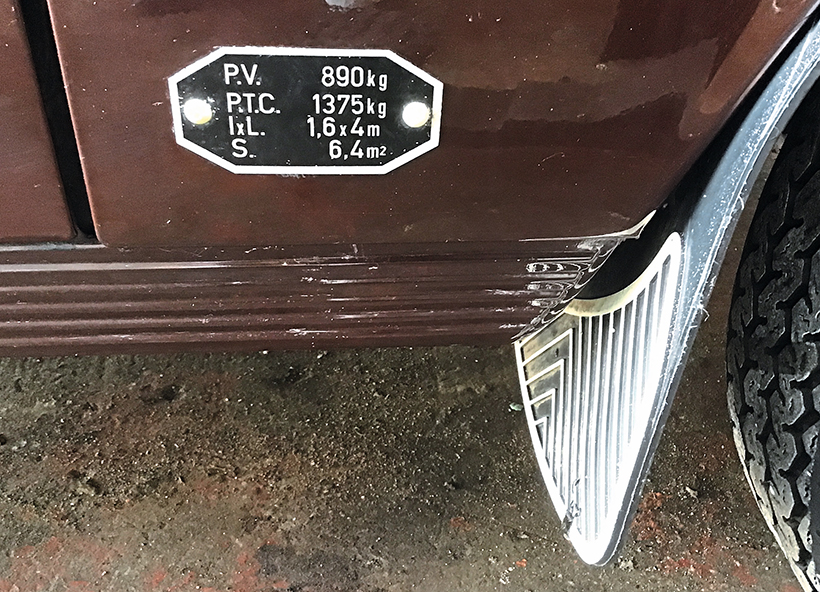
Weight panel display as required by French law.
Two intermediate pulleys were positioned on their sides but in-line vertically – ingenious but it meant a tortuous twisting journey for the belt. All pulleys must be 40% wider than normal to provide higher walls to guide the slightly twisted belt to enter and remain in the groove. To avoid shortening the belt life, the load on it was reduced considerably by using a thermo-electric coupling between the fan pulley and its hub (as we have today), controlled by a sensor in the engine cylinder head. The fan is always disconnected unless the engine temperature gets too high.

VIN plate with details.
An alternative would have been to use a viscous coupling, this would allow the drive to be normal up to the point when the effort to drive the fan became intentionally too much for the stickiness of the coupling’s connecting fluid, and it started slipping. The cooling fan is only needed when the engine is running but the van is stuck in traffic or when the road speed is very low, at higher road speeds there is enough cooling effect – this coupling would allow this.

Trapezoidal headlamps were the latest fashion and worked well.
Inside the spacious cab are two adjustable, reclining seats, covered in a ‘soft-touch’ plastic in light tan shade. A good range of instruments and gauges were provided. Three dials are in front of the driver: the necessary speedo with milometer and trip, central is a three-sector indicator for petrol, battery condition, and temperature, all are identified by symbols; jerry can, battery, and thermometer – an international language and easily understood. To the right a clock!
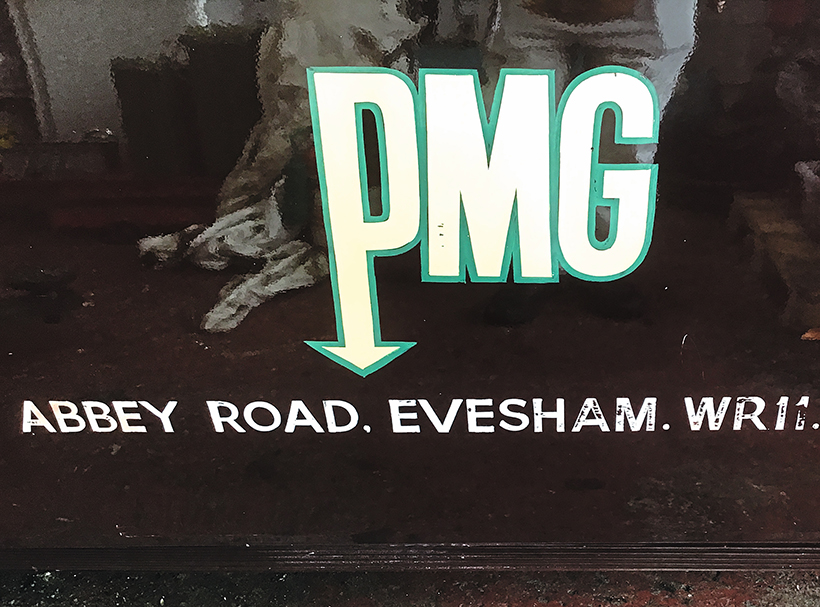
PMG local address in Evesham.
The all-chrome bumpers are correct for the year (the following year black rubber inserts were added). Details of weight are displayed prominently low down on the offside front wing – as required by French law (this van could carry 9.5cwt). Typical of the 1970s is the fitting of mud flaps all round – usually an ‘extra’ on many other vans of the era. Typically, very French is the three-bolt fixing of the road wheels.
My sincere thanks to management and staff at Andrew Hardy Classics for their help and hospitality.
This feature comes from the latest issue of Heritage Commercials, and you can get a money-saving subscription to his magazine simply by clicking HERE

Previous Post
1903 Burrell 8hp traction engine returns to the road

Next Post
Sampling a well-travelled 1974 Ford 5000 tractor



